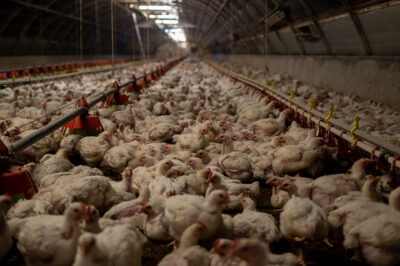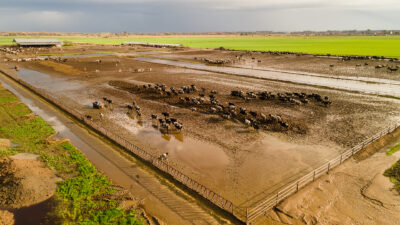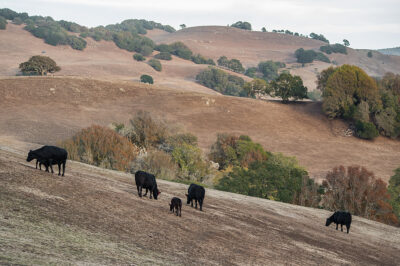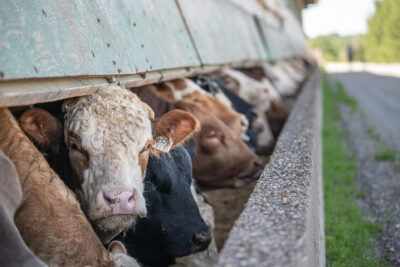The number of land animals being farmed globally grew from 7.3 billion in 1970 to 24.2 billion in 2011. In 2019 that number was estimated at 31 billion alive at any given time, with a further 38.8 billion to 215.9 billion fish, the vast majority of whom are raised on intensive farms. This style of farming comes at huge cost to the welfare of the animals, the environment, and the health of humans.
WHAT IS INTENSIVE ANIMAL FARMING?
Intensive animal farming is a way of farming animals that maximises production while keeping costs low. These kinds of farms are also known as factory farms. A farm specifically counts as intensive under UK regulations if it has capacity to house 40,000 chickens or other birds, whether raised for meat or eggs; 2,000 pigs of 30kg or more; and/or 750 sows (female breeding pigs).
Animals are kept at high stocking densities, meaning each individual is given very little room to move. And everything from their feed to the amount of light they get is unnatural and regulated. Intensive farms aim to bring animals up to slaughter weight as fast as possible, and to get dairy cows and egg-laying hens to produce as much as possible with the smallest amount of costs to the farmer.
WHAT ARE THE TYPES OF INTENSIVE ANIMAL FARMING?
Over the last 100 years, most forms of farming have changed dramatically in order to produce more food more cheaply, and to compete internationally. For farmed animals this has meant the rise of intensive farming and an unimaginable amount of suffering.
CHICKENS
More chickens are farmed and slaughtered for meat every year than any other land animal. A 2023 estimate suggests 34 billion are alive on Earth at any one time, and in 2016 a staggering 66 billion chickens were killed worldwide. Around 70 per cent are raised in intensive farming systems. While the UK and EU banned tiny battery cages in 2012, and the EU intends to ban all cages by 2027, British and European laying hens can still be confined in cages, which hold around 80 birds and contain a scratch mat and perches. Intensive barn systems don’t use cages but can house up to 50,000 chickens in one packed shed. Elsewhere in the world, including the US, Asia, Canada, and Australia, battery cages are still widely in use.
PIGS
In intensive pig farming, pigs are kept indoors all their lives on concrete or slatted floors and female breeding pigs (the mothers whose babies are taken from them for slaughter) are kept in farrowing crates while they nurse their piglets. In the UK, 60 per cent of pig farming is intensive, with each pig given just one square metre of space. The farrowing crates in which these mothers are confined for up to five weeks, are too small for them to even turn around in.
Europe, China, and the US have the highest concentrations of farmed pigs. In 2022, China opened the world’s largest intensive pig farm, a 26-storey building with capacity to slaughter a million pigs a year to supply the country’s rocketing demand for pig meat.
CATTLE
Both dairy and beef cows are farmed intensively. Beef cows might graze on pasture initially and then be moved into feedlots to be fattened on grain before being slaughtered. These American-style Concentrated Animal Feeding Operations (CAFOs), housing at least 1,000 cows, are becoming more common in the UK, though the exact number is unknown since they don’t require a government permit, unlike intensive farms for chickens and pigs. The largest known beef cattle CAFO in the UK has capacity for up to 3,000 cows.
Dairy cows are more likely to spend their entire lives in heavily mechanised indoor farms, where they are artificially inseminated in order to give birth to a calf every year so that they can produce milk almost continuously. After all, cows produce milk for their calves, not for us. The modern dairy cow produces twice as much milk as she did just 40 years ago, at an average of 22 litres a day in the UK, or as much as 30 litres a day for US dairy cows.
The intensive dairy industry also supports meat production, as dairy cows who are no longer productive (after about three years) are slaughtered for meat, and their male calves, who are considered useless to dairy farming, may either be shot at a few days old or slaughtered for veal.
AQUACULTURE
Industrial aquaculture has boomed across the world in recent decades. Intensive farms keep the fish at a high stocking density, and depend on processed imported feed, including soya harvested from deforested Amazon lands. Some fish farms are on land, with fish kept in large tanks, while others are a series of pens located in the open sea. Finfish like salmon are the most commonly farmed species. Salmon farming is the biggest type of aquaculture in the UK, with most farms concentrated off the coast of Scotland. Government data shows that 45.5 million salmon were raised in offshore farms in 2015. Carnivorous fish like salmon are fed a diet of fishmeal — derived from wild-caught species like anchovies. In this way, fish farming drives the destruction of ocean ecosystems.
WHAT ARE THE DISADVANTAGES OF INTENSIVE ANIMAL FARMING?
ANIMAL CRUELTY
Intensive farming means serious and prolonged suffering for the animals trapped in this system. A large part of this suffering is inherent in the factory farming model: animals being kept confined together, packed into indoor spaces with insufficient room; they are selectively bred to be as productive as possible, but this almost always compromises their health and wellbeing. For example, egg-laying hens are pushed to lay far too many eggs, and for these they need calcium. Inevitably, the production of all those eggshells weakens their bones and leads to osteoporosis and fractures.
CHICKENS
Let’s start with the size of modern broiler chickens — this is the term for the birds who are farmed for their meat. These poor birds have been selectively bred to grow much faster than they would naturally. They now reach a slaughter weight in just five or six weeks, three times faster than the birds who were farmed in the 1950s. All that weight is hard for their skeletal system to cope with, and bone fractures and joint dislocations are all too common as a result. Being kept in overcrowded barns means they don’t have enough space to move around or stretch their wings freely. The barn floors are typically cleaned only after a flock has been sent to slaughter, so the chickens sit around in their own waste, which is acidic and can burn their skin. Egg-laying hens suffer too. Even the bigger “enriched” cages many European and British hens are kept in don’t give them enough space or ability to engage in natural behaviours. Hens often have part of their beaks cut off to stop them from pecking each other, which causes both acute and chronic pain. Male chicks born into the egg industry are unwanted and are thrown alive into grinding machines or gassed to death on their first day of life.
PIGS
Being kept in crowded, barren sheds is stressful for these bright and inquisitive animals. As a result, farmed pigs are prone to nipping and biting each other. To prevent damage from this, which dents profits, piglets often have their teeth clipped and their tails cut off without anaesthetic. These practices are only supposed to be carried out in the UK as a last resort, but the conditions on intensive pig farms are so bad that this is a very common practice. Undercover investigations have revealed that physical abuse and neglect of pigs occur on an alarming number of farms.
COWS
In the dairy industry, calves are separated from their mothers usually a day after being born, which is stressful for both the calves and their mothers. But their ordeal doesn’t end there; the female offspring may join the dairy herd while the male calves are unwanted as they cannot produce milk. Some are transported to European veal farms, and will be sent on punishing journeys of up to 19 hours. If their tiny bodies cannot be monetised in another way, they will simply be shot at birth. Dairy cows, meanwhile, spend much of their day standing on concrete floors, which can lead to chronic pain and lameness, which is thought to affect a quarter of dairy cows at any one time. Mastitis, the inflammation of the udder, is one of the most common health problems experienced by dairy cows globally, and it is horribly painful.
FISH
Some species of farmed fish like Atlantic salmon are migratory species, navigating across great distances in their lifetimes. Confined to overcrowded sea pens, they are unable to perform these natural behaviours and become highly stressed. Farmed fish can become infested with parasites like sea lice that eat their flesh — something that they generally don’t suffer from in the wild. The method of slaughter for most farmed fish is also cruel, as they are left to suffocate in the air or on ice.
RISKS TO HUMAN HEALTH
Intensive animal farming presents multiple risks to human health. One growing concern right now is bird flu, which has been tearing through flocks across the world. In 2021, seven workers on a poultry farm in Russia contracted the H5N8 strain of bird flu. All recovered and there was no human-to-human transmission, but the recent spread of the H5N1 strain to mammals, including mink being intensively farmed for their fur in Spain, has got experts more worried about the potential for it to be transmitted more easily among humans.
Other pathogens can also spread and mutate under intensive farming conditions. For example, the bacteria Campylobacter jejuni, commonly found in farmed cows, is the most common cause of gastroenteritis and is resistant to antibiotics. The World Health Organization considers antibiotic resistance, which is driven in part by the use of antibiotics in animal farming, to be one of the most serious threats to public health. Pollution from intensive animal farms is also a big health concern. Air pollution from animal farms is bad for the respiratory health of both farmers and nearby residents.
WHY ARE ANTIBIOTICS GIVEN TO INTENSIVELY FARMED ANIMALS?
Animal farming is responsible for 70–80 per cent of antibiotic use globally, because the number of farmed animals on earth is far greater than the number of humans and the conditions they are kept in are so bad that they cannot survive without them. Antibiotics are supposed to be used to treat sick animals, but it has become common to use them to prevent animals from getting sick in the first place. In some countries they are also used liberally as they increase growth rates and productivity in animals, which boosts profits for farmers, even while it risks the health of people worldwide from antibiotic-resistant pathogens.
HOW DOES INTENSIVE FARMING AFFECT THE ENVIRONMENT?
Intensive farming causes many types of environmental damage. The large amounts of manure created by high-density farming pollute the land, air, and waterways. For example, increased chicken farming near the river Wye has severely polluted the water in recent years, killing aquatic life.
DEFORESTATION
Intensively farmed animals are generally fed on diets of corn, soya, and other crops. Some of these are grown on land that was once tropical forest. Soya production has historically helped to drive deforestation in the Amazon, and 77 percent of all soya is fed to farmed animals. Soya production continues to expand, usually into pasture land, which in turn causes more deforestation to create more pasture. Deforestation releases huge amounts of carbon dioxide, threatens the survival of many wild species, and makes fragmented and degraded forests more prone to wildfires.
HOW MANY BRANDS RELY ON INTENSIVE FARMING?
Fast food restaurants like McDonald’s, Nando’s, and KFC depend on intensive animal farming to sell huge amounts of burgers, chicken nuggets, and other items cheaply. Supermarkets are also guilty of selling meat and dairy from intensively farmed animals. Tesco, Sainsbury’s, Morrisons, and Asda are among those that sell chicken from major producers like Moy Park and Cargill, which operate intensive megafarms housing as many as 1.7 million chickens.
INTENSIVE ANIMAL FARMING FACTS
- Many animals farmed intensively don’t survive long enough to be slaughtered. Nearly three million farmed fish may be dying on Scottish fish farms every month, while 64 million chickens are estimated to die prematurely on British farms every year.
- Intensively farmed animals also suffer when they are exported to other countries. Almost two billion animals, including piglets, chickens, and calves, are exported around the world every year on journeys that are incredibly stressful and cruel.
- The most common method for slaughtering farmed animals in the UK is gassing, used for pigs and poultry. A bolt to the head is the most common method for cows.
CONCLUSION
Most farmed animals are raised on intensive farms, and suffer throughout their lives as a result. While some welfare protections exist for these animals, the conditions on intensive farms are so bad that they would be illegal for dogs or cats. These farms also compromise public health, pollute the environment, and contribute to climate change. The best way to end the horrors of intensive farming is to stop consuming animal products.
